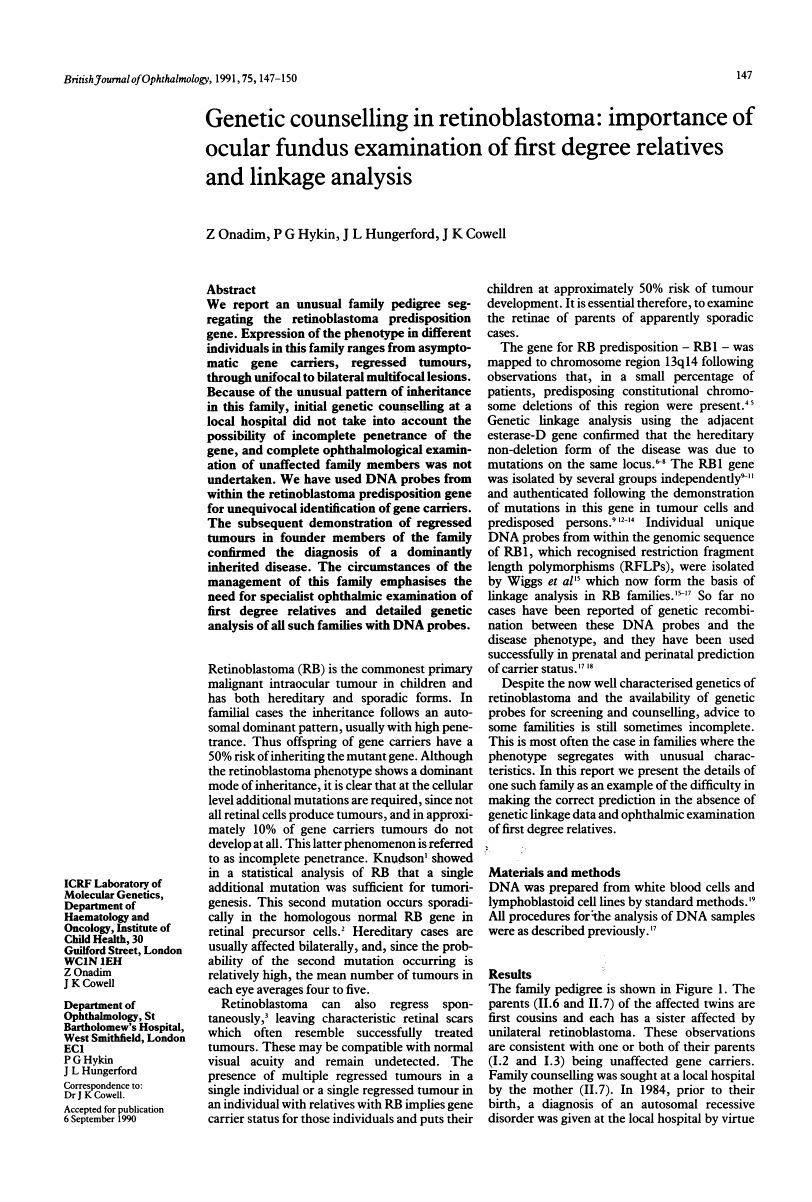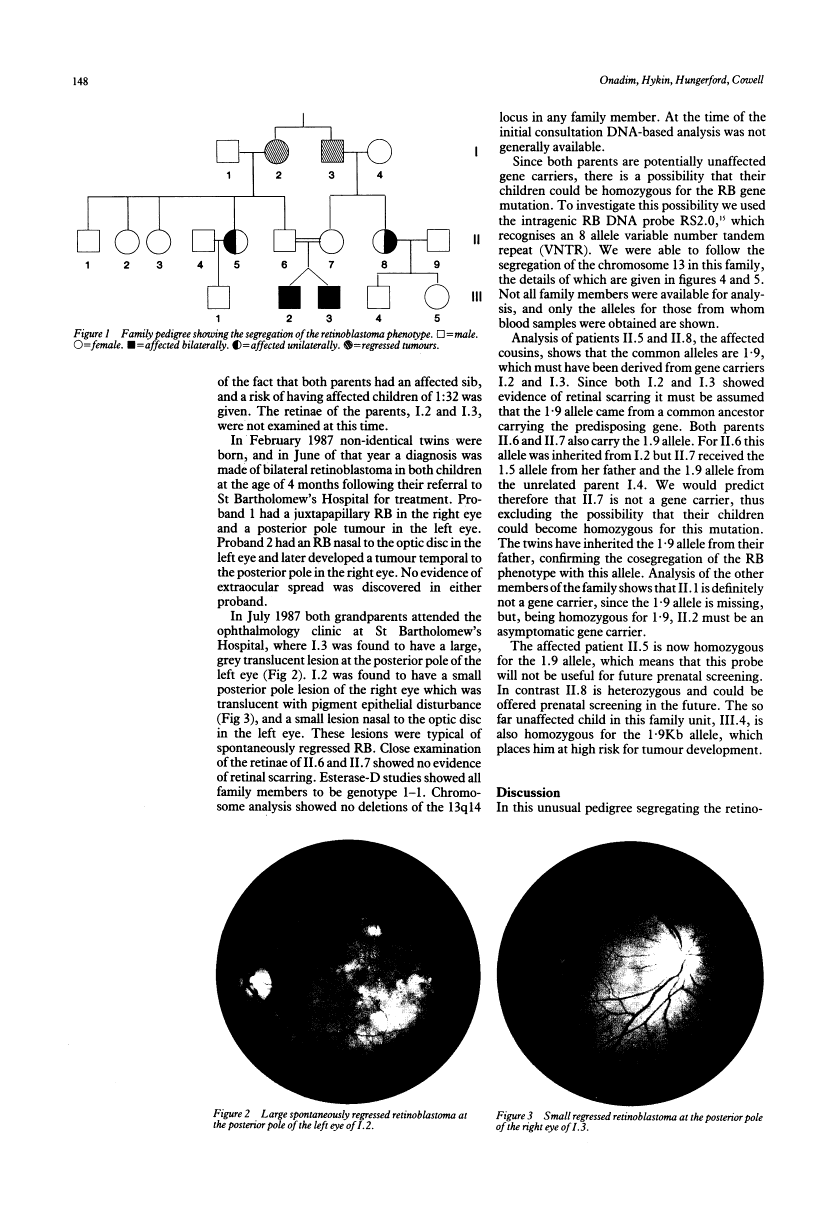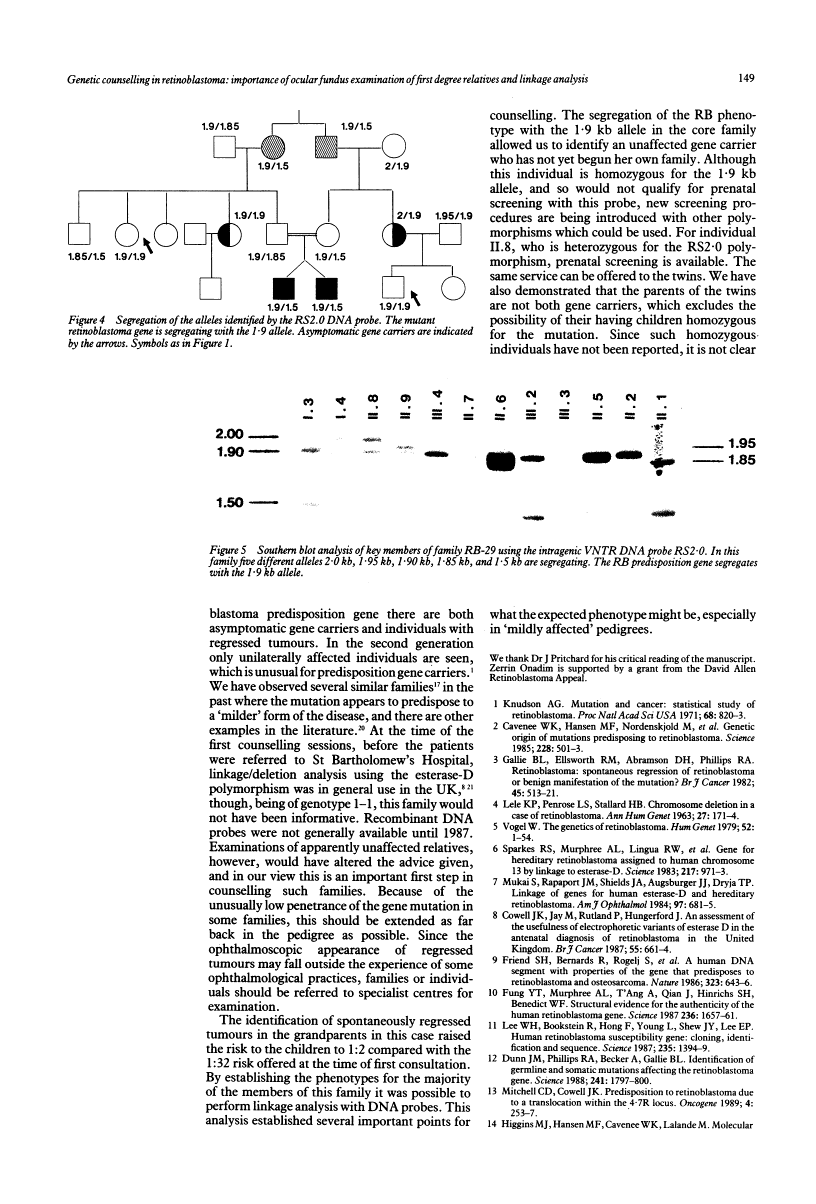Abstract
Free full text

Genetic counselling in retinoblastoma: importance of ocular fundus examination of first degree relatives and linkage analysis.
Abstract
We report an unusual family pedigree segregating the retinoblastoma predisposition gene. Expression of the phenotype in different individuals in this family ranges from asymptomatic gene carriers, regressed tumours, through unifocal to bilateral multifocal lesions. Because of the unusual pattern of inheritance in this family, initial genetic counselling at a local hospital did not take into account the possibility of incomplete penetrance of the gene, and complete ophthalmological examination of unaffected family members was not undertaken. We have used DNA probes from within the retinoblastoma predisposition gene for unequivocal identification of gene carriers. The subsequent demonstration of regressed tumours in founder members of the family confirmed the diagnosis of a dominantly inherited disease. The circumstances of the management of this family emphasises the need for specialist ophthalmic examination of first degree relatives and detailed genetic analysis of all such families with DNA probes.
Full text
Full text is available as a scanned copy of the original print version. Get a printable copy (PDF file) of the complete article (960K), or click on a page image below to browse page by page. Links to PubMed are also available for Selected References.
Images in this article
Selected References
These references are in PubMed. This may not be the complete list of references from this article.
- Knudson AG., Jr Mutation and cancer: statistical study of retinoblastoma. Proc Natl Acad Sci U S A. 1971 Apr;68(4):820–823. [Europe PMC free article] [Abstract] [Google Scholar]
- Cavenee WK, Hansen MF, Nordenskjold M, Kock E, Maumenee I, Squire JA, Phillips RA, Gallie BL. Genetic origin of mutations predisposing to retinoblastoma. Science. 1985 Apr 26;228(4698):501–503. [Abstract] [Google Scholar]
- Gallie BL, Ellsworth RM, Abramson DH, Phillips RA. Retinoma: spontaneous regression of retinoblastoma or benign manifestation of the mutation? Br J Cancer. 1982 Apr;45(4):513–521. [Europe PMC free article] [Abstract] [Google Scholar]
- LELE KP, PENROSE LS, STALLARD HB. CHROMOSOME DELETION IN A CASE OF RETINOBLASTOMA. Ann Hum Genet. 1963 Nov;27:171–174. [Abstract] [Google Scholar]
- Vogel F. Genetics of retinoblastoma. Hum Genet. 1979 Nov 1;52(1):1–54. [Abstract] [Google Scholar]
- Sparkes RS, Murphree AL, Lingua RW, Sparkes MC, Field LL, Funderburk SJ, Benedict WF. Gene for hereditary retinoblastoma assigned to human chromosome 13 by linkage to esterase D. Science. 1983 Feb 25;219(4587):971–973. [Abstract] [Google Scholar]
- Mukai S, Rapaport JM, Shields JA, Augsburger JJ, Dryja TP. Linkage of genes for human esterase D and hereditary retinoblastoma. Am J Ophthalmol. 1984 Jun;97(6):681–685. [Abstract] [Google Scholar]
- Cowell JK, Jay M, Rutland P, Hungerford J. An assessment of the usefulness of electrophoretic variants of esterase-D in the antenatal diagnosis of retinoblastoma in the United Kingdom. Br J Cancer. 1987 Jun;55(6):661–664. [Europe PMC free article] [Abstract] [Google Scholar]
- Friend SH, Bernards R, Rogelj S, Weinberg RA, Rapaport JM, Albert DM, Dryja TP. A human DNA segment with properties of the gene that predisposes to retinoblastoma and osteosarcoma. Nature. 1986 Oct 16;323(6089):643–646. [Abstract] [Google Scholar]
- Fung YK, Murphree AL, T'Ang A, Qian J, Hinrichs SH, Benedict WF. Structural evidence for the authenticity of the human retinoblastoma gene. Science. 1987 Jun 26;236(4809):1657–1661. [Abstract] [Google Scholar]
- Lee WH, Bookstein R, Hong F, Young LJ, Shew JY, Lee EY. Human retinoblastoma susceptibility gene: cloning, identification, and sequence. Science. 1987 Mar 13;235(4794):1394–1399. [Abstract] [Google Scholar]
- Dunn JM, Phillips RA, Becker AJ, Gallie BL. Identification of germline and somatic mutations affecting the retinoblastoma gene. Science. 1988 Sep 30;241(4874):1797–1800. [Abstract] [Google Scholar]
- Mitchell CD, Cowell JK. Predisposition to retinoblastoma due to a translocation within the 4.7R locus. Oncogene. 1989 Feb;4(2):253–257. [Abstract] [Google Scholar]
- Wiggs J, Nordenskjöld M, Yandell D, Rapaport J, Grondin V, Janson M, Werelius B, Petersen R, Craft A, Riedel K, et al. Prediction of the risk of hereditary retinoblastoma, using DNA polymorphisms within the retinoblastoma gene. N Engl J Med. 1988 Jan 21;318(3):151–157. [Abstract] [Google Scholar]
- Scheffer H, te Meerman GJ, Kruize YC, van den Berg AH, Penninga DP, Tan KE, der Kinderen DJ, Buys CH. Linkage analysis of families with hereditary retinoblastoma: nonpenetrance of mutation, revealed by combined use of markers within and flanking the RB1 gene. Am J Hum Genet. 1989 Aug;45(2):252–260. [Europe PMC free article] [Abstract] [Google Scholar]
- Onadim ZO, Mitchell CD, Rutland PC, Buckle BG, Jay M, Hungerford JL, Harper K, Cowell JK. Application of intragenic DNA probes in prenatal screening for retinoblastoma gene carriers in the United Kingdom. Arch Dis Child. 1990 Jul;65(7 Spec No):651–656. [Europe PMC free article] [Abstract] [Google Scholar]
- Mitchell C, Nicolaides K, Kingston J, Hungerford J, Jay M, Cowell J. Prenatal exclusion of hereditary retinoblastoma. Lancet. 1988 Apr 9;1(8589):826–826. [Abstract] [Google Scholar]
- Connolly MJ, Payne RH, Johnson G, Gallie BL, Allderdice PW, Marshall WH, Lawton RD. Familial, EsD-linked, retinoblastoma with reduced penetrance and variable expressivity. Hum Genet. 1983;65(2):122–124. [Abstract] [Google Scholar]
- Cowell JK, Rutland P, Jay M, Hungerford J. Deletions of the esterase D locus from a survey of 200 retinoblastoma patients. Hum Genet. 1986 Feb;72(2):164–167. [Abstract] [Google Scholar]
Associated Data
Articles from The British Journal of Ophthalmology are provided here courtesy of BMJ Publishing Group
Full text links
Read article at publisher's site: https://doi.org/10.1136/bjo.75.3.147
Read article for free, from open access legal sources, via Unpaywall:
https://bjo.bmj.com/content/bjophthalmol/75/3/147.full.pdf
Citations & impact
Impact metrics
Citations of article over time
Alternative metrics
Smart citations by scite.ai
Explore citation contexts and check if this article has been
supported or disputed.
https://scite.ai/reports/10.1136/bjo.75.3.147
Article citations
Chiasmatic infiltration secondary to late malignant transformation of retinoma.
Ophthalmic Genet, 33(3):155-158, 28 Apr 2011
Cited by: 3 articles | PMID: 21526971
Deletion of RB exons 24 and 25 causes low-penetrance retinoblastoma.
Am J Hum Genet, 61(3):556-570, 01 Sep 1997
Cited by: 48 articles | PMID: 9326321 | PMCID: PMC1715941
Investigation of the loss of heterozygosity and familial segregation by PCR in retinoblastoma.
Clin Biochem, 29(6):595-598, 01 Dec 1996
Cited by: 1 article | PMID: 8939409
Constitutional nonsense germline mutations in the RB1 gene detected in patients with early onset unilateral retinoblastoma.
Eur J Cancer, 32A(10):1749-1752, 01 Sep 1996
Cited by: 13 articles | PMID: 8983285
Bilateral spontaneously regressed retinoblastoma with preservation of vision.
Eye (Lond), 11 ( Pt 1):122-124, 01 Jan 1997
Cited by: 1 article | PMID: 9246292
Go to all (14) article citations
Similar Articles
To arrive at the top five similar articles we use a word-weighted algorithm to compare words from the Title and Abstract of each citation.
Application of PCR amplification of DNA from paraffin embedded tissue sections to linkage analysis in familial retinoblastoma.
J Med Genet, 28(5):312-316, 01 May 1991
Cited by: 17 articles | PMID: 1865468 | PMCID: PMC1016848
Application of intragenic DNA probes in prenatal screening for retinoblastoma gene carriers in the United Kingdom.
Arch Dis Child, 65(7 spec no):651-656, 01 Jul 1990
Cited by: 22 articles | PMID: 1974756 | PMCID: PMC1590195
[Clinical applications of molecular diagnosis of retinoblastoma ain 15 families].
Klin Monbl Augenheilkd, 206(5):336-338, 01 May 1995
Cited by: 0 articles | PMID: 7609380
The polymerase chain reaction (PCR) in the routine genetic characterization of retinoblastoma: a tool for the clinical laboratory.
Surv Ophthalmol, 41(4):331-340, 01 Jan 1997
Cited by: 4 articles | PMID: 9104770
Review











